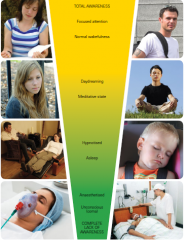![]()
![]()
![]()
Use LEFT and RIGHT arrow keys to navigate between flashcards;
Use UP and DOWN arrow keys to flip the card;
H to show hint;
A reads text to speech;
14 Cards in this Set
- Front
- Back
|
Consciousness |
Is the awareness of objects and events in the external world and of our own existence and mental experiences at any given moment.
Content of our consciousness - Includes our perceptions, content of our minds, awareness of our emotions, memories, thoughts, attitudes and beliefs, sense of self personal identity. It is personal, subjective, selective, continuous and changing. |
|
|
States of consciousness |

Different levels of awareness of our internal state determines how much information on the external environment that we receive and take in. These states are divided into two categories: NWC and ASC. |
|
|
Normal Waking Consciousness (NWC) |
Refers to the states of consciousness associated with being awake and aware of our thoughts, memories, feelings and the sensations we are experiencing from the external world.
Characteristics of NWC - Includes: clear and organised perceptions, strong sense of personal identity, awareness of the world, a sense of time and place, and our awareness and our attention shifts continually between states. |
|
|
Attention |
Is a concentration of mental activity that involves focusing on specific stimuli while ignoring other stimuli.
Divided attention - Refers to the ability to distribute our attention and undertake two or more activities simultaneously.
Selective attention - Involves an individual to precisely focus on certain stimuli while ignoring other stimuli. We pay attention to stimuli that is personally important to us or if it is novel(new) to us.
Cocktail party phenomenon - Even though you are focused on your own conversation, your attention will be automatically drawn to another conversation if you hear your own name.
|
|
|
Content limitations |
In NWC the content we take in is more restricted than ASC. The content is also more logical and organised in NWC where as in ASC the content is often nonsensical and disorganised. |
|
|
Controlled processes |
Involves conscious, alert awareness and mental effort in which the individual actively focuses their attention on achieving a particular goal. Often required when the task is new or difficult and can only focus on that particular task and not multi-task. |
|
|
Automatic processes |
Requires little conscious awareness and mental effort, minimal attention and does not interfere with the performance of other activities.
|
|
|
Altered States of Consciousness (ASC) |
Any state of consciousness that is distinctly different from NWC in terms of level of awareness and experience, and the quality or intensity of sensations, perceptions, thoughts, feelings and memories that are experienced.
Characteristics of ASC
Level of awareness - is increased or decreased depending on the ASC.
Content limitations - Increased or decreased depending on ASC. Content can be broader or deeper and is normally disorganised and nonsensical.
Controlled and automatic processes - Our ability to perform these processes become cut off or difficult.
Perceptual and cognitive distortions - Our senses become more receptive to stimuli or dull.
Emotional awareness - Emotions are heightened or intensified and are sometimes inappropriate than our normal sequence of behaviour.
Self-control - is lowered. Our inhibitions are lowered so we are more open to suggestion. ASC's like hypnosis can give us greater self-control.
Time orientation - distortions in our time distortion.
|
|
|
Naturally occurring ASC's |
Includes sleep(can also be purposely induced), daydreaming and dreaming.
|
|
|
Purposely induced ASC's |
Includes meditation, hypnosis, alcohol ingestion, certain medication and illegal drugs. |
|
|
Daydreaming |
Is an ASC in which we shift our attention from external stimuli to internal thoughts, feelings and imagined scenarios. Daydreams have minimal eye movement and high levels of alpha brain waves.
|
|
|
Alcohol-induced state |
An ASC in which the chemicals change our conscious awareness, perception or moods. It is a depressant.
Variables influencing the effects - Includes concentration of alcohol consumed, amount consumed, conditions under which there was consumption and variables related to the individual.
Effects of alcohol on consciousness - Includes: shortened attention span, impaired perceptions, thinking and memory, slower reaction times, reduced self-awareness, impaired emotional awareness and control, impaired perception of time, difficulties with voluntary muscular control and fine movement and deterioration in complex tasks.
BAC level - concentration (%) of alcohol in the blood. As BAC level increases, it influences the brain stem which controls bodily functions such as breathing, heart rate and consciousness.
|
|
|
Psychological construct |
A concept that is constructed to describe specific psychological activity that is believed to exist but cannot be directly observed or measured.
|
|
|
Measures of states of consciousness |
Includes: body temperature, EEG, heart rate and GSR
Galvanic skin response (GSR) - Is a physiological response that indicates the change in the resistance of the skin's surface to electrical current so it measures electrical conductivity of the skin. More moisture means decreased resistance. GSR can be linked with emotional experiences and level of awareness. |

